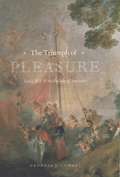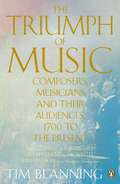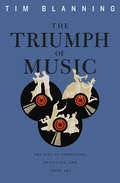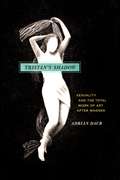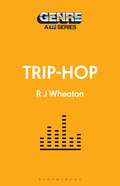- Table View
- List View
The Triumph of Pleasure: Louis XIV and the Politics of Spectacle
by Georgia J. CowartProminent components of Louis XIV’s propaganda, the arts of spectacle also became sources of a potent resistance to the monarchy in late seventeenth-century France. With a particular focus on the court ballet, comedy-ballet, opera, and opera-ballet, Georgia J. Cowart tells the long-neglected story of how the festive arts deployed an intricate network of subversive satire to undermine the rhetoric of sovereign authority. With bold revisionist strokes, Cowart traces this strain of artistic dissent through the comedy-ballets of Jean-Baptiste Lully and Molière, the late operatic works of Lully and the operas of his sons, the opera-ballets of André Campra and his contemporaries, and the related imagery of Antoine Watteau’s well-known painting The Pilgrimage to Cythera. She contends that through a variety of means, including the parody of old-fashioned court entertainments, these works reclaimed traditional allegories for new ideological aims, setting the tone for the Enlightenment. Exploring these arts from the perspective of spectacle as it emerged from the court into the Parisian public sphere, Cowart ultimately situates the ballet and related genres as the missing link between an imagery of propaganda and an imagery of political protest.
The Triumph of Music: Composers, Musicians and Their Audiences, 1700 to the Present (Penguin Modern Classics)
by Tim BlanningOnce musicians such as Mozart were little more than court servants; now they are multimillionaire superstars wielding more power than politicians. How did this extraordinary change come about? Tim Blanning's brilliantly enjoyable book examines how everything from the cult of the romantic to technology and travel all fed the inexorable rise of music in the West, making it the most dominant and ubiquitous of the art forms. Encompassing balladeers, the great composers, jazz legends and rock gods, this is an enthralling story of power, patronage, creativity and genius.
The Triumph of Music: The Rise of Composers, Musicians and Their Art
by Tim BlanningA distinguished historian chronicles the rise of music and musicians in the West from lowly balladeers to masters employed by fickle patrons, to the great composers of genius, to today’s rock stars. How, he asks, did music progress from subordinate status to its present position of supremacy among the creative arts? Mozart was literally booted out of the service of the Archbishop of Salzburg “with a kick to my arse,” as he expressed it. Yet, less than a hundred years later, Europe’s most powerful ruler—Emperor William I of Germany—paid homage to Wagner by traveling to Bayreuth to attend the debut of The Ring. Today Bono, who was touted as the next president of the World Bank in 2006, travels the world, advising politicians—and they seem to listen. The path to fame and independence began when new instruments allowed musicians to showcase their creativity, and music publishing allowed masterworks to be performed widely in concert halls erected to accommodate growing public interest. No longer merely an instrument to celebrate the greater glory of a reigning sovereign or Supreme Being, music was, by the nineteenth century, to be worshipped in its own right. In the twentieth century, new technological, social, and spatial forces combined to make music ever more popular and ubiquitous. In a concluding chapter, Tim Blanning considers music in conjunction with nationalism, race, and sex. Although not always in step, music, society, and politics, he shows, march in the same direction.
Tristan's Shadow: Sexuality and the Total Work of Art after Wagner
by Adrian DaubDas Rheingold, Die Walküre, and Siegfried. Parsifal. Tristan und Isolde. Both revered and reviled, Richard Wagner conceived some of the nineteenth century’s most influential operas—and created some of the most indelible characters ever to grace the stage. But over the course of his polarizing career, Wagner also composed volumes of essays and pamphlets, some on topics seemingly quite distant from the opera house. His influential concept of Gesamtkunstwerk—the “total work of art”—famously and controversially offered a way to unify the different media of an opera into a coherent whole. Less well known, however, are Wagner’s strange theories on sexuality—like his ideas about erotic acoustics and the metaphysics of sexual difference. Drawing on the discourses of psychoanalysis, evolutionary biology, and other emerging fields of study that informed Wagner’s thinking, Adrian Daub traces the dual influence of Gesamtkunstwerk and eroticism from their classic expressions in Tristan und Isolde into the work of the generation of composers that followed, including Zemlinsky, d’Albert, Schreker, and Strauss. For decades after Wagner’s death, Daub writes, these composers continued to grapple with his ideas and with his overwhelming legacy, trying in vain to write their way out from Tristan’s shadow.
Tristan's Shadow: Sexuality and the Total Work of Art after Wagner
by Adrian DaubDas Rheingold, Die Walküre, and Siegfried. Parsifal. Tristan und Isolde. Both revered and reviled, Richard Wagner conceived some of the nineteenth century’s most influential operas—and created some of the most indelible characters ever to grace the stage. But over the course of his polarizing career, Wagner also composed volumes of essays and pamphlets, some on topics seemingly quite distant from the opera house. His influential concept of Gesamtkunstwerk—the “total work of art”—famously and controversially offered a way to unify the different media of an opera into a coherent whole. Less well known, however, are Wagner’s strange theories on sexuality—like his ideas about erotic acoustics and the metaphysics of sexual difference. Drawing on the discourses of psychoanalysis, evolutionary biology, and other emerging fields of study that informed Wagner’s thinking, Adrian Daub traces the dual influence of Gesamtkunstwerk and eroticism from their classic expressions in Tristan und Isolde into the work of the generation of composers that followed, including Zemlinsky, d’Albert, Schreker, and Strauss. For decades after Wagner’s death, Daub writes, these composers continued to grapple with his ideas and with his overwhelming legacy, trying in vain to write their way out from Tristan’s shadow.
Tristan's Shadow: Sexuality and the Total Work of Art after Wagner
by Adrian DaubDas Rheingold, Die Walküre, and Siegfried. Parsifal. Tristan und Isolde. Both revered and reviled, Richard Wagner conceived some of the nineteenth century’s most influential operas—and created some of the most indelible characters ever to grace the stage. But over the course of his polarizing career, Wagner also composed volumes of essays and pamphlets, some on topics seemingly quite distant from the opera house. His influential concept of Gesamtkunstwerk—the “total work of art”—famously and controversially offered a way to unify the different media of an opera into a coherent whole. Less well known, however, are Wagner’s strange theories on sexuality—like his ideas about erotic acoustics and the metaphysics of sexual difference. Drawing on the discourses of psychoanalysis, evolutionary biology, and other emerging fields of study that informed Wagner’s thinking, Adrian Daub traces the dual influence of Gesamtkunstwerk and eroticism from their classic expressions in Tristan und Isolde into the work of the generation of composers that followed, including Zemlinsky, d’Albert, Schreker, and Strauss. For decades after Wagner’s death, Daub writes, these composers continued to grapple with his ideas and with his overwhelming legacy, trying in vain to write their way out from Tristan’s shadow.
Tristan's Shadow: Sexuality and the Total Work of Art after Wagner
by Adrian DaubDas Rheingold, Die Walküre, and Siegfried. Parsifal. Tristan und Isolde. Both revered and reviled, Richard Wagner conceived some of the nineteenth century’s most influential operas—and created some of the most indelible characters ever to grace the stage. But over the course of his polarizing career, Wagner also composed volumes of essays and pamphlets, some on topics seemingly quite distant from the opera house. His influential concept of Gesamtkunstwerk—the “total work of art”—famously and controversially offered a way to unify the different media of an opera into a coherent whole. Less well known, however, are Wagner’s strange theories on sexuality—like his ideas about erotic acoustics and the metaphysics of sexual difference. Drawing on the discourses of psychoanalysis, evolutionary biology, and other emerging fields of study that informed Wagner’s thinking, Adrian Daub traces the dual influence of Gesamtkunstwerk and eroticism from their classic expressions in Tristan und Isolde into the work of the generation of composers that followed, including Zemlinsky, d’Albert, Schreker, and Strauss. For decades after Wagner’s death, Daub writes, these composers continued to grapple with his ideas and with his overwhelming legacy, trying in vain to write their way out from Tristan’s shadow.
Trip-Hop (Genre: A 33 1/3 Series)
by R.J. WheatonTrip-hop described some of the 1990s' best music, and it was one of the decade's most revealing bad ideas. The music itself was an intoxication of beats, bass, and voice. It emerged amid the social tensions of the late 1980s, and as part of hip-hop's rise to global dominance. It carried the innovations of Jamaican soundsystem culture, the sweet refuge of Lovers Rock, the bliss of club jazz dancefloors and post-rave chill-out rooms. It went mainstream with Massive Attack, Portishead, Tricky, DJ Shadow, Kruder & Dorfmeister, and Björk; and with record labels like Ninja Tune and Mo' Wax. To the artists' despair, the music was tagged with a silly label and packaged as music for the boutique and the lounge; made respectable with awards and acclaim. But the music at its best still sounds experimental and dramatic; and its influence lingers through artists like FKA twigs, Sevdaliza, James Blake, Billie Eilish, and Lana Del Rey. This short book is a guide to 'trip-hop' in its context of the weird 1990s: nostalgia and consumerism; pre-millenium angst and lo-fi technology; casual exoticism amid accelerating globalization and gentrification. This book presents a survey of the music and its leading artists, packed with recommended listening, essential tracks, great remixes, and under-recognized albums.
Trip-Hop (Genre: A 33 1/3 Series)
by R.J. WheatonTrip-hop described some of the 1990s' best music, and it was one of the decade's most revealing bad ideas. The music itself was an intoxication of beats, bass, and voice. It emerged amid the social tensions of the late 1980s, and as part of hip-hop's rise to global dominance. It carried the innovations of Jamaican soundsystem culture, the sweet refuge of Lovers Rock, the bliss of club jazz dancefloors and post-rave chill-out rooms. It went mainstream with Massive Attack, Portishead, Tricky, DJ Shadow, Kruder & Dorfmeister, and Björk; and with record labels like Ninja Tune and Mo' Wax. To the artists' despair, the music was tagged with a silly label and packaged as music for the boutique and the lounge; made respectable with awards and acclaim. But the music at its best still sounds experimental and dramatic; and its influence lingers through artists like FKA twigs, Sevdaliza, James Blake, Billie Eilish, and Lana Del Rey. This short book is a guide to 'trip-hop' in its context of the weird 1990s: nostalgia and consumerism; pre-millenium angst and lo-fi technology; casual exoticism amid accelerating globalization and gentrification. This book presents a survey of the music and its leading artists, packed with recommended listening, essential tracks, great remixes, and under-recognized albums.
Trinity Grade 8 Theory Past Papers 2019
by Trinity College London PressTrinity Grade 8 Theory Past Papers 2019
Trinity Grade 8 Theory Model Answers 2019
by Trinity College London PressTrinity Grade 8 Theory Model Answers 2019
Trinity Grade 7 Theory Past Papers 2019
by Trinity College London PressTrinity Grade 7 Theory Past Papers 2019
Trinity Grade 7 Theory Model Answers 2019
by Trinity College London PressTrinity Grade 7 Theory Model Answers 2019
Trinity Grade 6 Theory Past Papers 2019
by Trinity College London PressTrinity Grade 6 Theory Past Papers 2019
Trinity Grade 6 Theory Model Answers 2019
by Trinity College London PressTrinity Grade 6 Theory Model Answers 2019
Trinity Grade 5 Theory Past Papers 2019
by Trinity College London PressTrinity Grade 5 Theory Past Papers 2019
Trinity Grade 5 Theory Model Answers 2019
by Trinity College London PressTrinity Grade 5 Theory Model Answers 2019
Trinity Grade 4 Theory Past Papers 2019
by Trinity College London PressTrinity Grade 4 Theory Past Papers 2019
Trinity Grade 4 Theory Model Answers 2019
by Trinity College London PressTrinity Grade 4 Theory Model Answers 2019
Trinity Grade 3 Theory Past Papers 2019
by Trinity College London PressTrinity Grade 3 Theory Past Papers 2019
Trinity Grade 3 Theory Model Answers 2019
by Trinity College London PressTrinity Grade 3 Theory Model Answers 2019
Trinity Grade 2 Theory Past Papers 2019
by Trinity College London PressTrinity Grade 2 Theory Past Papers 2019
Trinity Grade 2 Theory Model Answers 2019
by Trinity College London PressTrinity Grade 2 Theory Model Answers 2019
Trinity Grade 1 Theory Past Papers 2019
by Trinity College London PressTrinity Grade 1 Theory Past Papers 2019
